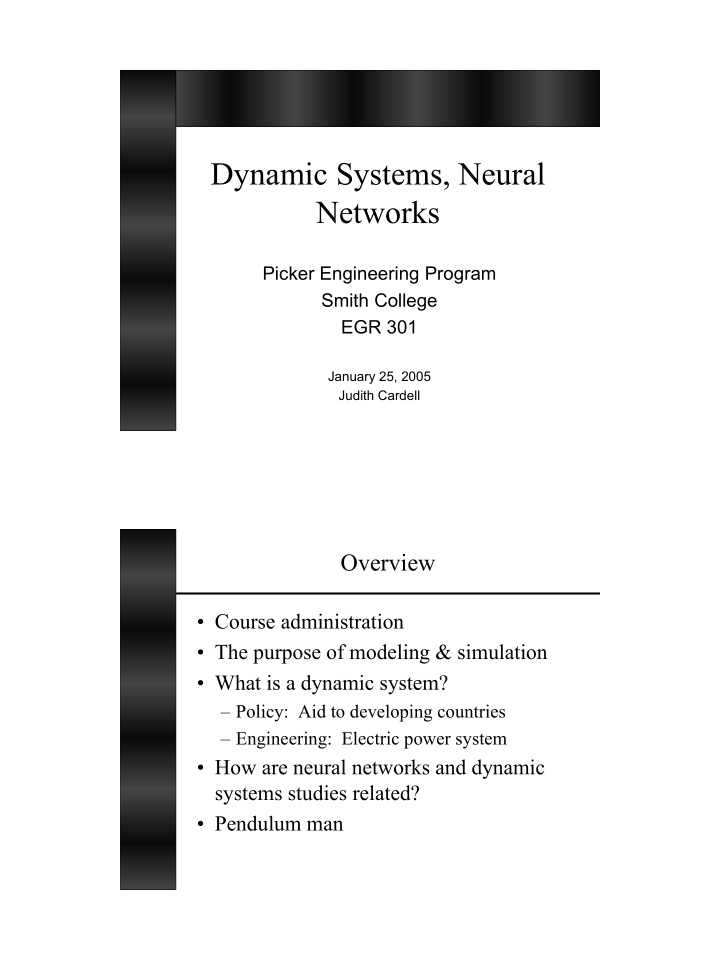



Dynamic Systems, Neural Networks Picker Engineering Program Smith College EGR 301 January 25, 2005 Judith Cardell Overview • Course administration • The purpose of modeling & simulation • What is a dynamic system? – Policy: Aid to developing countries – Engineering: Electric power system • How are neural networks and dynamic systems studies related? • Pendulum man
Modeling and Simulation Systems Experiment with a Experiment with model of a actual system system Mathematical Physical model model Computer Analytic Solution Simulation Systems to Model & Simulate • Dynamic system – System • A combination of interacting elements • …that act together to perform a specific objective – Dynamic • Systems or phenomena that produce time-changing patterns • ... that evolve or change with time • Policy analysis • Engineering analysis
Policy: Causal Loop Diagram • A method for diagramming and understanding relationships between system elements, especially feedback • Positive feedback shown below Policy: Causal Loop Diagram • Additional dynamics (relationships and time evolution) – Population � leads to death � – Death � leads to population �
The Tragedy of the Sahel • Narrow strip of land south of the Sahara desert • Limited resources have limited the size of both nomad and grazing animal populations – Every 20-30 years drought killed many – Populations maintained at viable levels • Nomad survival system – Depended upon moving grazing animals often • In the 1960s aid organizations tried to help the nomad population • Steps taken by organizations – Introduce modern medicine • Greatly increased nomad lifespan • Controlled animal diseases – Increase availability of water with modern technology • Increased the number of animals the nomads could own
The Tragedy of the Sahel • A list of important system elements – Nomad population – Animal population • Small populations – Limited food – Limited water – Limited herds – Severe climate • Severe drought – Disease – Poor diets Modeling the Tragedy of the Sahel • The number of nomads and the number of cattle interact with almost every other element • Arrows show which elements affect the number of nomads
The Tragedy of the Sahel • Arrows show which elements are affected by the number of nomads The Tragedy of the Sahel • Arrows to show everything that affects and is affected by the number of cattle
The Tragedy of the Sahel • Results of intervention Animals died of starvation Nomads died of starvation – The increased animal population ate and trampled the little grass that had been available – A cyclic drought further decimated grass • Unanticipated result!! • The UN was faced with a problem larger than the one they initially tried to ‘solve’ The Tragedy of the Sahel • A list of important system elements – Nomad population – Modern medicine – Deeper wells – Animal population – Increased number • Small populations of animals – Limited food – Limited – Limited water grasslands – Limited herds • Eaten – Severe climate • Trampled – Animals starved • Severe drought – People starved – Disease – Poor diets
The Tragedy of the Sahel • Outside intervention added • (+) (–) feedback signs added The Tragedy of the Sahel • What happened?! – Adding the ‘positive’ input of water counteracted the ‘negative’ feedback of water � as nomad population � – Intervention removed the negative feedback that previously maintained the system • Introducing medicine and water together allowed both populations to grow larger than the ecosystem could support
Modeling Systems • Use of causal loop diagrams – Constructing a diagram is straightforward – Understanding the dynamics in a diagram is more difficult • System behavior can only be understood with the use of quantitative (mathematical) simulation models – The behavior of a system cannot be determined from such a diagram Blackouts
Power System Variables • Input data: Generators produce, and we consume, two commodities – Real power, P - useful work – Reactive power, Q - system EM support • Output (measured) data – Single system-wide frequency, f (60Hz) – Voltage levels specified for each location
Operating the Power System • All values of interest evolve over time – they are dynamic, and they are inter- related (coupled) – Power generation and consumption (load) Power flows change with load changes and with equipment failure – Frequency is maintained close to 60Hz – Voltage is maintained close to its “set point” What Happened in August 2003? Lines and generators overloaded and tripped offline Power flow moved to other lines and demand to other generators
What Happened in August 2003? • Problems in southern Ohio distracted operators • Computers for monitoring the power system down in northern Ohio and at Midwest system operator • Insufficient reactive power (voltage support) in northern Ohio – Suspicions that new market conditions (restructuring) led to this result Power System Modeling • Obtain or derive mathematical equations (models) of each power system element • Determine the coupling between each element • Using known input, output and system parameter data, check that your model correctly simulates system behavior • Use the model to predict system behavior with new input data scenarios
Neural Networks Exercise: Pendulum Man • How would you model the behavior of this system using – Dynamic system modeling – Neural network modeling
Summary • Introduction to simulation • Introduction to dynamic systems • Introduction to neural networks – Compare and contrast dynamic systems and neural net modeling • Matlab review
Recommend
More recommend